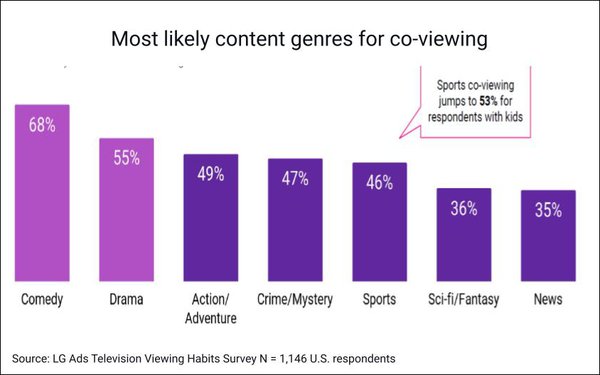
Connected TV content has a 13% higher
attention index and a 74% higher co-viewing incidence than linear TV content, according to new data from CTV measurement firm TVision in a study that also included a survey by LG Ad Solutions with a
U.S. census-balanced panel of 1,146.
Households with kids are even more likely to pay attention to streaming content and ads:

The research “supports our existing
knowledge that consumers are paying more attention to streaming content than linear content,” says TVision CEO Yan Liuu. “High-attention content gives advertisers a valuable opportunity to
increase engagement and generate outcomes.”
advertisement
advertisement
TVision uses a camera sensor, digital meter and measurement engine with a panel of 5,000 U.S. homes to measure CTV content attention and
advertising attention. This study focused on content measurement, but the report also includes some findings relating to advertising attention — including insights on the effects of ad length
and frequency on attention (more on those below).
In the LG Ad Solutions survey, 88% of respondents reported co-viewing streaming television, 67% said they pay the same or more attention to
programming when co-viewing, and 54% said they pay the same or more attention to ads when co-viewing. Nearly three quarters (73%) said they multi-task the same amount or less when co-viewing as when
streaming alone.
Seventy-five percent report watching sports on cable or satellite, versus 53% for streaming. But the gap in co-viewing is considerably smaller: 66% co-view
when watching on traditional pay TV, versus 56% co-viewing when streaming.

Comedy and drama are the content genres most likely to be
co-viewed:

The data indicate not only that streaming TV viewers are on average more likely to be watching with other people than linear TV viewers, but also that they tend to pay more
attention to the screen when co-viewing, notes Tony Marlow, CMO at LG Ad Solutions. "This could mean that streaming may be a much more shared experience than previously realized and that this helps
drive a higher level of attention for content and ads," he adds.
On the advertising attention front, the study confirmed an inverse relationship between attention and
ad length, underscoring the importance of conveying the brand and message in the first 15 seconds.

It also confirmed that attention is at its highest on the
first exposure to a CTV ad and gradually declines as frequency increases — reinforcing the importance of determining the optimal frequency for the brand and the creative and then actively
managing it.

TVision's own ongoing, twice-yearly reports on CTV advertising attention have shown that CTV has been steadily gaining on linear TV on that front, and had nearly closed the
gap, until this year's first half. During that period, CTV/streaming ad
attention slipped to 29.6%, from 31.2% in 2H 2022, while linear's ad attention score rose to 34.1%, from 33.7% in 2H 2022.